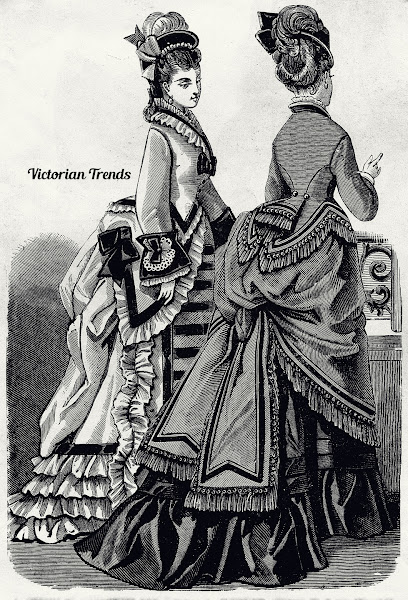Antique fashion illustration from the December 1901 issue of
The Delineator. The magazine says: "
On the left, charming simplicity marks this gown, for which black crêpe de Chine was chosen in combination with jetted lace, rowa of ribbons of graduated widths and narrow ruffles of the crêpe de Chine. The waist is in low, rounding outline at the top, a short distance from which a ruffle of the material is arranged so that with the jetted lace it suggests a bertha. A closing is made at the back with small buttons, and the front blouses with becoming fulness [sic]. The cap sleeves are circularly shaped, and a ribbon belt describes the dip.
An inverted box-plait takes up the fulness at the back of the five-gored skirt, and a graduated, circular flounce is added. Several narrow ruffles arranged on the flounce near the bottom give a fluffy effect. White embroidered mousseline de soie will evolve a handsome evening gown, with medallion of black lace on white-edged black chiffon. A sash of black chiffon would be a pretty adjunct. Nile-green Louisine with appliqués of point Venise lace, or black dotted net over white taffeta will make a smart gown, and bows of black velvet and Liberty silk ruffles will be dainty as graniture.
On the right, tucks are employed in the decoration of this waist, which is low and square at the neck where it is outlined by a shallow bertha. The fronts puff out prettily and are tucked at the top and bottom, while the back is tucked to suggest a girdle. A closing is arranged to the left side. Tucked sleeves are also introduced, terminating in a puff at the elbow. A crush belt of panne velvet is worn, and the material employed in the development was Nile-green Lansdowne with self-colored dots. Cream lace appliqué was applied on the bertha.
The skirt is also of the Lansdowne, trimmed to match the bodice. It is circular and has a graduated flounce of similar shaping, while the back is in habit style. Pale-yellow taffeta will make up well in this gown, and the indispensable touch of black may be introduced in a
chou of chiffon at the left of the corsage. Crêpe de Chine, mousseline both plain and dotted, and the various new silks are appropriate, and a ribbon belt may be used.

All digitized work by Victorian Trends.com is licensed under a
Creative Commons Attribution-NonCommercial 4.0 International License.
Free for personal use only. Please link back to VictorianTrends.com as your source when sharing or publishing.

















